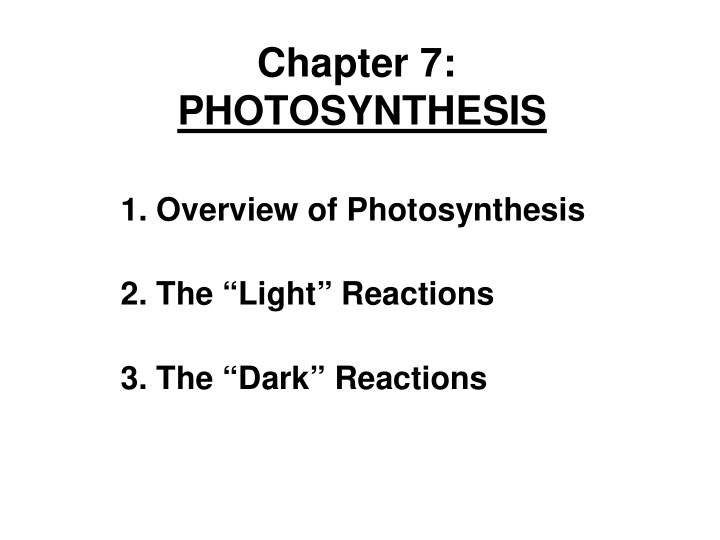



Chapter 7: PHOTOSYNTHESIS 1. Overview of Photosynthesis 2. The “Light” Reactions 3. The “Dark” Reactions
1. Overview of Photosynthesis
What is Photosynthesis? The process of converting light energy (kinetic) into energy stored in the covalent bonds of glucose molecules (potential) . Light energy CO 2 H 2 O C 6 H 12 O 6 O 2 6 + 6 + 6 Carbon dioxide Water Glucose Oxygen gas PHOTOSYNTHESIS • carried out by photoautotrophs • plants, phytoplankton, cyanobacteria (any photosynthetic organism) • the basis of almost all ecosystems • all “food energy” ultimately comes from the sun • source of all atmospheric oxygen (O 2 )
Photosynthesis vs Respiration essentially the reverse of each other
Photosynthesis occurs in Chloroplasts Mesophyll Cell Leaf Cross Section Leaf Chloroplast CO 2 O 2 Chloroplast
The Chloroplast outer membrane inner membrane stroma thylakoid granum
Photosynthesis consists of 2 sets of Reactions The light-dependent or “Light” Reactions: • convert sunlight H 2 O CO 2 Chloroplast energy into Light chemical energy NADP + (stored in ATP & ADP NADPH) + P CALVIN LIGHT “Dark” Reactions CYCLE REACTIONS (in stroma) (in thylakoids) (Calvin cycle): ATP E l e c t r o n • use chemical s NADPH energy from light reactions O Sugar to make glucose
(“Light”) Reactions 2. Light-dependent
Light Reactions occur in Thylakoids A variety of light-absorbing pigments & electron transport proteins are embedded within the thylakoid membrane
The Pigments absorb “Visible” Light Chlorophyll a & b: • the major pigments (absorb red, blue…, reflect green) Carotenoids (e.g., β -carotene) • accessory pigments (absorb green, blue, reflect red, yellow)
Absorption Range for each Pigment red blue
Chlorophyll absorbs “non-green” light energy Light Reflected light • green light passes on through or is reflected, causing the leaves to appear green Absorbed light Chloroplast Transmitted light
H 2 O ½ O 2 + 2 H + + 2 *e - PS I 1 2 PS II e - transport chain (ETC) pumps H + into thylakoid
2 e - to 4 PS II NADPH PS I 3 ATP Synthase uses H + flow to make ATP
Light Energy absorbed by Pigments Fuels 4 General Steps of the “Light Reactions”: 1) H 2 O split to O, 2 H + & 2 high energy e - (*e - ) in PS II sunlight H 2 O O 2 + H + + *e - 2) Energy released by a series of *e - transfers is used to generate H + gradient • H + accumulates inside the thylakoid membrane 3) H + gradient used to make ATP (chemiosmosis) 4) *e - “re-energized” in PS I, passed on to NADP + • *e - ends up in NADPH (an electron carrier)
Analogy of e – Light reactions ATP e – e – NADPH e – e – e – Mill Photon makes ATP e – n o t o h P Photosystem II Photosystem I
Summary of the Chloroplast “Light” Reactions Stroma (low H + concentration) H + H + Light Light ATP ADP + P H + + H + NADP + NADPH H + Thylakoid membrane H + H + H 2 O 1 H + H + H + O 2 + 2 H + H + H + H + 2 H + Photosystem II Electron Photosystem I ATP synthase H + transport chain Thylakoid space (high H + concentration)
3. Light-independent (“Dark”) Reactions
The “Dark” Reactions A series of reactions called the Calvin cycle that synthesize glucose from CO 2 and H 2 O: ATP, NADPH CO 2 + H 2 O C 6 H 12 O 6 (glucose) • uses energy stored in ATP and NADPH • produced by the light reactions • can occur in dark (doesn’t require light directly) • also occurs during daylight! • takes place in the stroma of chloroplasts • outside the thylakoids
“Dark” Reactions Involves an anabolic pathway known as the Calvin cycle: Calvin cycle • endergonic reactions of this pathway are fueled by ATP & NADPH from the “light” reactions • resulting sugars can be Don’t used as a source of memorize this!! energy or to build other organic molecules
Summary of Photosynthesis stroma
Key Terms for Chapter 7 • photoautotroph • chloroplast, thylakoid, stroma • chlorophyll, carotenoids • ATP, NADPH • electron transport chain (ETC) • ATP synthase • Light reactions, dark reactions, Calvin cycle Relevant Review Questions: 1-6, 8-10, 12
Recommend
More recommend